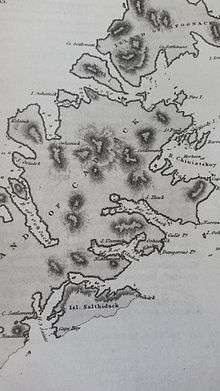Three Saints Bay
|
Three Saints Bay Site | |
 | |
|
1802 lithograph engraving depicting the site | |
 | |
| Nearest city | Old Harbor, Alaska |
|---|---|
| Coordinates | 57°8′57″N 153°29′17″W / 57.14917°N 153.48806°WCoordinates: 57°8′57″N 153°29′17″W / 57.14917°N 153.48806°W |
| Built | 1784 |
| Architect | Unknown |
| Architectural style | No Style Listed |
| NRHP Reference # | 72001541 |
| Significant dates | |
| Added to NRHP | February 23, 1972[1] |
| Designated NHL | June 02, 1978[2] |

Three Saints Bay (Russian: Бухта Трёх Святителей, r Bukhta Trëkh Svyatitelyei) is a 9 miles (14 km)-long inlet on the southeast side of Kodiak Island, Alaska, north of Sitkalidak Strait.[3] It is 97 km (60 mi) southwest of Kodiak. The Three Saints Bay Site is an archaeological site which was the location of the first Russian settlement in Alaska, Three Saints Harbor (Гавань Трех Святителей, Gavan’ Trekh Svyatitelyei). The settlement was founded in 1784 by Grigory Shelikhov,[4]:163 but the main settlement was moved to Pavlovskaya, now the city of Kodiak, in 1792.[5]:7 The Three Saints Bay Site was declared a National Historic Landmark in 1978.[2]
History
Although Russian fur hunters had established temporary shore stations in Alaska earlier, the Three Saints site was intended to be a permanent colonial settlement. The site was poorly chosen, for the hillside above the shore area was too steep to build on, and the shore area was too small for a substantial settlement. When it was visited in 1790, it was described as a cluster of small structures (probably barabaras), with a population of about fifty men and a small number of women. The site was harmed by subsidence and a probable tsunami in the wake of a 1788 earthquake, and Alexander Baranov in 1791 began moving the settlement to the location of present-day Kodiak. The site continued to be occupied as a smaller station of lesser importance until roughly the mid-19th century, at which time it was relocated to a site about 2 kilometres (1.2 mi) away.[6]
Only a few remnants of the Russian occupation remain on the surface. These are mainly pits and rectangular depressions, indications of where structures were located, and some plants that are evidence of the small-scale agriculture which was practiced there. The settlement's cemetery was located to its southeast. Excavation at the site also yielded evidence that it was built on the site of an older native settlement, dating to c. 100 BCE.[6]
The Russian settlement site was listed on the National Register of Historic Places in 1972, and was designated a National Historic Landmark in 1978.[1]
Etymology
The bay was named for the harbor, in turn named after one of Shelikhov's ships, itself named for the Three Holy Hierarchs. It was reported by Petroff in the 10th Census in 1880.[7]
The same area was later called Lyakhik Bay (Zaliv Lyakhik) by Captain Tebenkov.[8] This was based on its Aleut name Liakik,[9] probably from liak ("black-footed goose").[3][10]
See also
- Awa'uq Massacre
- Maritime Fur Trade
- List of National Historic Landmarks in Alaska
- National Register of Historic Places listings in Kodiak Island Borough, Alaska
References
- 1 2 Staff (2007-01-23). "National Register Information System". National Register of Historic Places. National Park Service.
- 1 2 "Three Saints Bay Site". National Historic Landmark summary listing. National Park Service. Retrieved 2008-01-04.
- 1 2 "Three Saints Bay". Geographic Names Information System. United States Geological Survey. Retrieved 2009-05-03.
- ↑ Brown, S.R., 2009, Merchant Kings, New York:St. Martin's Press, ISBN 9780312616113
- ↑ Khlebnikov, K.T., 1973, Baranov, Chief Manager of the Russian Colonies in America, Kingston: The Limestone Press, ISBN 0919642500
- 1 2 Clark, Donald W (1985). "Archaeological Test at the Russian Three Saints Bay Colony, Alaska". Historical Archaeology (Volume 19, No. 2): 144–121. JSTOR 25615550.
- ↑ Petroff, 1893, p. 32.
- ↑ 1852, map 23.
- ↑ Baker, 1906, p. 625.
- ↑ Geoghegan, R.H. Notes. He proposes it as a dual form, meaning "pair of geese".
| |||||||||||||||||||||
| ||||||||||||||||||||||||||
| ||||||||||||||||||||||||||


